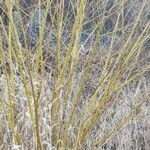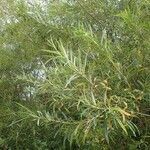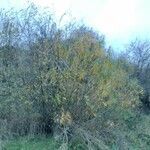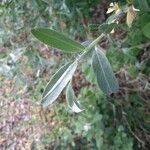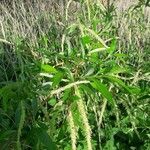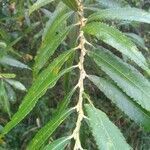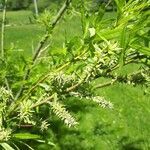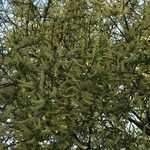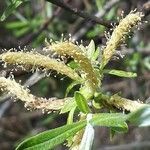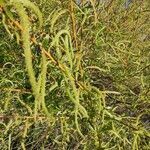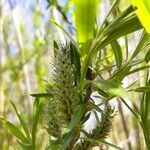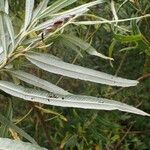Small tree with rather smooth trunk, or erect shrub to c. 8 m high, often suckering extensively; branches few. Shoots long, straight, flexible, green or yellowish green, densely hairy at first, later glabrous, lacking striations below bark. Buds white-tomentose. Petiole very short. Lamina 5-18 × 0.5-2 cm, linear to lanceolate, becoming glabrous and dark shining green above, silvery, usually greenish white, sometimes green beneath, ± silky hairy beneath, not bitter to taste; margins entire, often somewhat revolute; apex acuminate. Stipules small. Catkins appearing before or sometimes as lvs emerge, erect or suberect; rachis densely hairy or tomentose. ? catkins 1.5-4.5 cm long, cylindric. Bracts 1.2-3.2 mm long, obovate, or elliptic-obovate, black in upper 1/2-3/4, with long silky hairs, with acute apex. Gland 1 (sometimes 2-3 united), 0.6-1.2-(1.5) mm long, linear. Stamens 2, glabrous. ♀ catkins 2-5 cm long, cylindric; bracts and gland similar to ♂. Ovary sessile or subsessile, white-tomentose. Seed c. 1 mm long, cylindric.
Few-stemmed shrub or tree to 15 m; twigs slender, yellowish to reddish-brown, puberulent to glabrous; stipules mostly wanting, or lance-linear and to 9 mm; petioles to 1 cm; lvs lance-linear, 5–12(–17) cm × 5–15(–20) mm, long-acuminate, revolute, entire or shallowly undulate, dull green and puberulent with impressed veins above, densely short-sericeous with yellow midrib beneath, the primary lateral veins numerous, wide-angled; catkins with the lvs, subsessile, 2–6 cm, mostly naked; scales 1.5–2.5 mm, black, thinly villous; stamens 2; frs lanceolate, 4–6 mm, subsessile, densely short-sericeous; style 0.7–1.2 mm; 2n=38. Native of Eurasia, occasionally escaped from cult. in our range. A hybrid with S. caprea is S. ×smithiana Willd.
A shrub which loses its leaves during the year. It grows to 10 m tall and often has several flexible stems. The leaves are very long and narrow. They are green on top and have dense silvery hairs underneath. They have a sharp point and without teeth. The edges often roll inwards on the underside. Male and female catkins grow on separate twigs. The fruit are capsules covered with down. The fruit do not have stalks.
